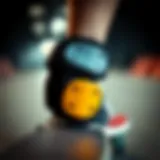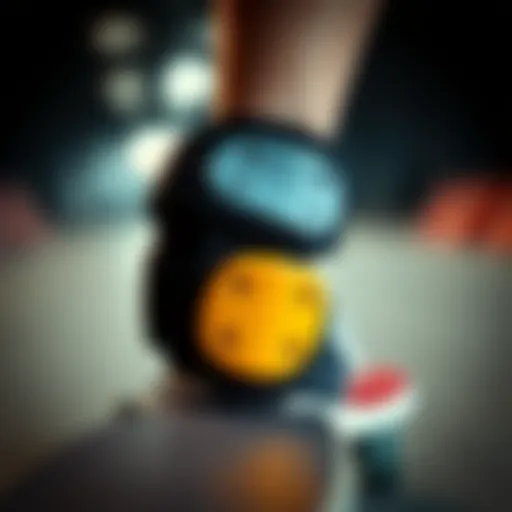A Complete Guide to Pre-Built Skateboards
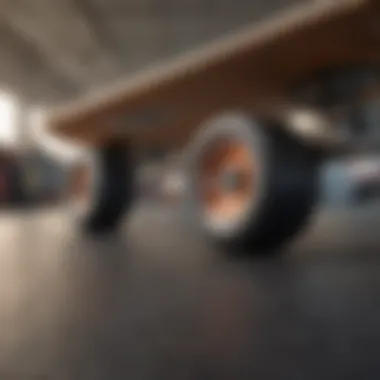

Extreme Sport Overview
Foreword to Skateboarding
Skateboarding, a form of extreme sport, marries creativity with physical skill. It's not just about getting from point A to B; it encapsulates a culture that thrives on expression and individuality. The allure of riding a board over concrete jungles and parks can be exhilarating. With its roots embedded deep in Californian surf culture of the late 1940s and early 1950s, skateboarding has transformed dramatically. Initially, skateboarders fashioned makeshift boards from wood and roller skate wheels. But today’s boards? They are finely engineered machines, made for high performance and specific tricks.
Brief History of the Sport
In its infancy, skateboarding was merely a way for surfers to practice when the ocean waves didn’t deliver. The 1960s saw the introduction of the plastic skateboard, which made it more affordable and accessible to the masses. The 1970s ushered in a new wave of innovation with the introduction of urethane wheels, dramatically improving performance. The 1980s and 1990s marked the golden era of skateboarding, thanks to the emergence of legendary skaters like Tony Hawk and the rise of street skating. Fast forward to today, skateboarding has found its place in the global sports arena, even making its debut in the Olympic Games.
Equipment Required
Skateboarding demands specific gear to ensure a smooth and safe ride. A few essentials include:
- Skateboard – Pre-built or custom-made, depending on skill level.
- Helmet – Protects against head injuries.
- Wrist guards and knee pads – Offer additional protection during falls.
- Skate shoes – Designed for grip and durability.
Safety Tips and Guidelines
Skateboarding, while thrilling, has its fair share of risks. Here are some safety tips to keep in mind:
- Always wear a helmet and protective gear.
- Learn to fall correctly, rolling out to minimize impact.
- Begin on flat surfaces before tackling ramps or tricks.
- Be mindful of your surroundings; avoid crowded areas.
Relevant Statistics and Facts
- Global Reach: As of recent studies, over 50 million people skate worldwide, with a substantial rise in interest among youth.
- Injury Rates: Skateboarding has a relatively low injury rate compared to other sports, but knee and wrist injuries are common, emphasizing the need for protective gear.
- Demographics: The average skater is between 10 and 29 years old, though many enthusiasts are older.
In understanding the world of skateboarding through the lens of pre-built skateboards, one begins to appreciate not only the equipment but also the lifestyle and community that surround it. With the right board, paired with safety gear, the prospect of hitting the streets becomes both thrilling and safe.
Preamble to Pre-Built Skateboards
Pre-built skateboards have become a cornerstone in the skateboarding realm, blending convenience and accessibility for riders at all stages of their journey. Understanding what pre-built skateboards are and their growing significance within the skateboarding culture is crucial. For many beginners, the concept of assembling a skateboard piece by piece can be as intimidating as learning to ride in the first place. Pre-built options offer a gateway, providing a readymade solution that allows the skater to hit the pavement without the worry of sourcing individual components.
When looking at the advantages, one must consider how pre-built boards are typically crafted by experienced manufacturers who prioritize quality and performance. This often results in a reliable ride, crafted with the best materials that are specifically chosen to optimize the board's weights, durability, and maneuverability. However, the world of skateboarding culture runs deeper than just riding; it's about identity, expression, and being part of something bigger. Choosing a pre-built skateboard can allow newcomers to dip their toes into this vibrant culture, fostering a sense of belonging from the get-go.
In essence, for those ready to roll, pre-built skateboards encapsulate not just a product but an invitation into a community that thrives on freedom, creativity, and athleticism. Let's delve deeper into the specifics, starting with a clear definition of what pre-built skateboards entail.
The Anatomy of a Pre-Built Skateboard
Understanding the anatomy of a pre-built skateboard is crucial for anyone interested in the nuances of skateboarding. Each component plays a specific role, influencing everything from performance to durability. When you strip a skateboard down to its parts, it’s easier to recognize what suits your riding style and skill level.
Deck Composition
The deck forms the heart of the skateboard, serving as the platform where riders stand. Typically constructed from layers of maple wood, the quality and number of layers significantly determine the strength and flexibility of the board. A seven-ply construction is common, balancing durability and weight, while nine-ply options offer added strength, appealing to riders who need more resilience during tricks.
- Material Matters: Some decks are made from bamboo or composite materials for lighter options, promoting easy maneuverability. Each material interacts with board feel; maple tends to provide a solid and stable foundation.
- Shape and Size: Deck sizes may vary—a wider board offers stability beneficial for beginners, while narrower boards cater to street skating and tricks, giving more freedom to flip and spin.
Trucks and Their Functionality
Trucks are the metal axles mounted on the deck, pivotal for turning and stability. Selecting the right trucks affects not only the board’s handling but also the rider's confidence.
- Height of Trucks: The height can vary; lower trucks provide a more stable ride and are preferable for street skaters aiming for tricks, while higher trucks offer better clearance for smooth rides on ramps.
- Material and Durability: Usually made from aluminum or steel, their weight and durability play an essential role in performance. Quality trucks that don’t bend under pressure can withstand rigorous skating without compromising the ride.
Wheels and Bearings Explained
Wheels, let’s not forget, are the contact point between the skateboard and the ground. They come in various sizes and durometers (hardness levels), which dictate how a board rides.
- Wheel Size: Smaller wheels are suited for technical skateboarding and tricks, while larger wheels provide a smoother ride, ideal for cruising or rough terrains.
- Bearings Quality: Bearings determine how smoothly the wheels roll. Higher ABEC ratings usually indicate precision and reduced friction. However, remember that it’s not just about speed; well-lubricated wheels can better absorb shocks.
Grip Tape: Importance and Variety
Grip tape is often the unsung hero of skateboarding. It is applied to the top of the deck to ensure riders maintain control.
- Functionality: The rough texture prevents feet from slipping, which is crucial when performing tricks or during fast-paced rides. Different grips offer various levels of texture, so finding one that feels right is essential.
- Aesthetic Choices: Beyond functionality, grip tape comes in numerous designs and colors, allowing skaters to express their style. Customizing the grip tape adds a personal touch to your board, making it more than just a means of transportation.
"A skateboard is not just a mode of conveyance; it's an extension of the rider's identity. Crafting the right board is just as vital as perfecting the tricks."
Overall, understanding each component of a pre-built skateboard is pivotal. When you know the materials, functions, and customization options available, you can make informed choices that enhance your riding experience. Each piece adds to a collective that should reflect your personal style and riding goals, ultimately shaping your skateboard journey.
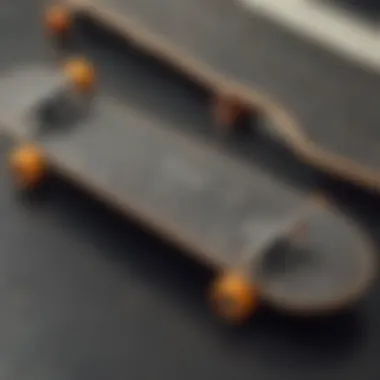

Advantages of Choosing a Pre-Built Skateboard
When diving into the world of skateboarding, one might be overwhelmed by the choices available. Opting for a pre-built skateboard can be a significant decision, influenced by various advantages that cater to different skill levels and budget constraints. Choosing a pre-built skateboard simplifies the process, offers financial benefits, and ensures a baseline of quality across brands. Understanding these benefits paints a clearer picture for both novice riders and experienced skaters alike.
Cost Efficiency Compared to Custom Builds
Pre-built skateboards often save you a pretty penny compared to custom builds. While crafting a personalized skateboard can be a rewarding journey, it quickly adds up. First off, the price of individual components – deck, trucks, wheels, bearings – can burden your budget like a sack of bricks.
- Affordability: A decent pre-built skateboard offers a complete setup at a relatively low price, typically ranging from a hundred to a few hundred dollars. This is a stark contrast to custom setups that can skyrocket above that.
- No Assembly Required: With pre-built options, you bypass the hassle of assembly which can save time as well as the need for tools you may not have. All pieces come ready to roll, making it easier to hit the pavement right away.
- Sales and Discounts: Many brands frequently dabble in sales, making it even easier to snag a reliable board without burning a hole in your wallet.
Given these affordability factors, pre-built skateboards appeal as a practical choice for both beginners and veterans wanting to save costs without sacrificing performance.
Convenience for Beginners
For those who are just starting their skateboarding journey, pre-built skateboards hold a treasure trove of convenience. Learning to ride can already feel like herding cats, so why complicate things with customization?
- User-Friendly: Pre-built skateboards come designed with beginners in mind. They’re tailored to provide a balance that helps new riders find their footing (literally). This user-centered vibe helps prevent the learning curve from feeling like a mountain.
- Simplicity: Selecting a board straight off the shelf cuts down decision fatigue. Beginners don't have to sift through the details of deck shapes, material contrasts, or wheel durometers. One pick can set them up with a quality board.
- Ready to Ride: With a pre-built skateboard, newcomers skip the worries of mismatching components, and they can head out for a ride without second-guessing their setup.
This convenience puts critical focus on improving skills rather than getting bogged down with construction options.
Quality Assurance from Reputable Brands
Quality can often be a concern for anyone spending their hard-earned cash. Thankfully, pre-built skateboards by reputable brands usually come packed with guarantees on craftsmanship.
- Trustworthy Materials: Established brands ensure their boards are made of durable materials. For instance, almost all pre-built skateboards by companies like Element or Plan B use high-quality maple wood known for its strength and flexibility.
- Testing: A significant advantage here is that these boards have undergone extensive testing. This means they’re designed to withstand the rigors of skateboarding without crumbling under pressure. Riders can trust that what they're standing on will hold up against their antics.
- Customer Support: With a reliable brand backing your product, customer service often comes into play for troubleshooting. Should an issue arise, help is generally easier to find through reputable manufacturers.
This assurance helps to relieve the concerns related to usability and breaks, giving former stressors a run for their money.
Potential Drawbacks of Pre-Built Options
As the landscape of skateboarding continues to evolve, opting for a pre-built skateboard can seem wise and pragmatic for many individuals. Yet, beneath the surface of convenience and lower price tags, there are aspects that participants in this sport must carefully consider. Understanding these potential drawbacks is vital for making an informed decision that aligns with one's specific needs and ambitions as a skater.
Limited Customization Opportunities
One significant limitation that comes with pre-built skateboards is the constraint on customization. While these boards are designed to perform satisfactorily out of the box, their design and components often lack the flexibility to adapt to individual preferences. For many experienced skaters, the ability to tweak a board's setup tailored to their unique style can be a deal-maker.
In the world of skateboarding, the phrase "It's not just about riding; it’s about how you ride" resonates strongly. If you ride ramps, technical street or long distances, you might find the one-size-fits-all boards lacking.
For instance, if a skater prefers softer wheels for better grip on rough terrain, a pre-built skateboard may come equipped with harder wheels that cater to another riding style. This lack of choice might lead to discomfort and performance issues.
- Interchangeability: With custom setups, different brands and models can be mixed and matched. Pre-built boards often lock you into a specific combination that may not totally suit your riding technique.
- Ppersonalization: A pre-built skateboard limits the chance for a rider to showcase their personality through unique designs or parts.
This can be less than ideal for those who want a board that not only performs but also tells their story.
Performance May Vary by Manufacturer
The skateboarding market is an eclectic mix of companies, each with its unique philosophy and approach to design. While some manufacturers are giants in the skateboarding realm, consistently producing high-quality products, others might not be as reliable. When you grab a pre-built skateboard, you're often at the mercy of the brand’s reputation. The performance of a skateboard can vary significantly depending on who makes it, affecting factors like durability, speed, and stability.
"Skateboarding is never about simplicity; it always demands a balance of performance and style."
Such variances can pose risks, particularly for serious riders who rely on their gear.
Another aspect to consider is that budgets might dictate choices. A more affordable pre-built board may appear attractive, but it could cut corners in areas like materials or engineering. This might lead to an unexpected experience when hitting the ramps or navigating city streets.
When comparing companies, keep an eye out for:
- Customer Reviews: See what past customers say regarding longevity and performance.
- Warranty Policies: Strong warranties often indicate manufacturer confidence.
Ultimately, an informed choice requires sleuthing the brands thoroughly to ensure you get the most bang for your buck.
In sum, while pre-built skateboards present a convenient option, it’s essential to weigh these potential drawbacks. Understanding the limitations and variations among manufacturers will arm you with knowledge as you navigate this exciting world. The goal is to put your best foot forward when riding, and knowing what to watch out for only enhances that experience.
Selecting the Right Pre-Built Skateboard
Choosing the right pre-built skateboard isn’t just about picking the flashiest design or the trendiest brand. It’s about understanding your personal needs and preferences. Whether you are just stepping onto the board or are a seasoned rider looking to level up your game, taking the time to select the right skateboard can significantly influence your riding experience. The right board can make everything from cruising on the streets to hitting the skate park feel rewarding and enjoyable.
Assessing Skill Levels: Beginner to Advanced
Understanding where you stand on the skill spectrum can drastically help narrow down your skateboard options. Beginners typically benefit from a stable and forgiving board, which is usually broader and has a softer flex. This tells you that learning balance and coordination can be easier. On the other hand, advanced riders might look for boards that offer more responsiveness and flexibility for tricks. They might prefer narrower decks that promote quick turns and flips.
As you transition between skill levels, it’s helpful to keep in mind that your board choice may change. Start simple, and don't be afraid to switch it up as your skill set grows.
Weight and Size Considerations
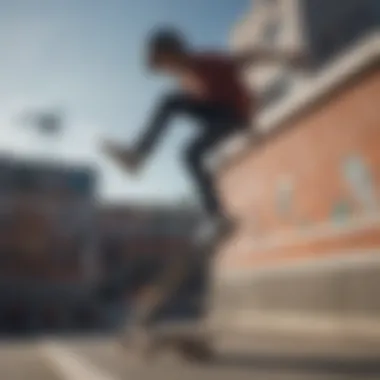

The weight and size of a skateboard can play a crucial role in your overall performance. A heavier board may not be as enjoyable for tricks, especially for folks who want to launch themselves into the air. Conversely, a lighter board can feel unstable, especially for beginners. In this regard, getting the right weight is vital for comfort and control.
The size of the skateboard deck also matters. Typically, wider boards provide more stability, while narrower ones allow for better maneuverability and are better suited for tricks. Your foot size should also be taken into account when deciding on the deck width. The right fit can enhance your grip and balance on the deck.
Types of Skateboards Available
When it comes to choosing a skateboard, you’ll find that these boards generally fall into distinct categories:
Longboards
Longboards are known for their extended decks, which allow for smooth rides over longer distances. These boards excel in providing stability, making them a preferred choice for cruising or downhill riding. Their key characteristic is the wheel base, which tends to be longer compared to street or trick boards. Longboards are popular among commuters who want a comfortable ride.
However, they typically lack the agility needed for technical tricks and tight spaces. This might not be the best fit for someone looking to perform stunts or navigate through crowded skate parks.
Street Boards
Street boards are the type of skateboard you most often see in urban environments. They're designed for tricks rather than cruising, which means they are usually lighter and have a more compact shape. This board's smaller wheels and trick-friendly deck shape make it adaptable for performances like ollies or grinds.
Though street boards excel in tricks, they may not provide the best ride for casual commuters. The stiff nature of these decks can make longer rides less comfortable. Thus, if you plan to ride for long periods, you may want to consider other options.
Trick Boards
Trick boards, similar to street boards, are tailored for performing skills and stunts. What sets them apart is their construction, often featuring heavier materials and the ability to withstand high impacts. They are built for durability.
The main advantage of trick boards is that they can handle a diverse range of tricks, offering riders the flexibility to innovate and improvise. However, for beginners, this can feel a bit daunting. The rigidity and specific sizing of these boards might result in a learning curve that can be a touch frustrating for those just starting out.
In sum, selecting the right pre-built skateboard is a deeply personal choice influenced by skill level, size, and type of skateboarding you intend to pursue. Understanding these elements can help guide your decision and ensure you land the right board to suit your style.
Top Brands in Pre-Built Skateboards
When it comes to pre-built skateboards, the brand you choose can make all the difference. Some manufacturers have established themselves as the go-to names in the industry, while others are just beginning to carve their niche. Understanding the strengths and weaknesses of various brands helps skaters make informed decisions. A solid skateboard is more than just a set of wheels; it can influence everything from performance to safety. Knowing which brands consistently deliver above and beyond can enhance your overall skating experience.
Popular Manufacturers and Their Weaknesses
Several established brands dominate the pre-built skateboard market, each bringing unique characteristics to their products. Let’s take a closer look at a few of them:
- Element Skateboards
- Santa Cruz Skateboards
- Baker Skateboards
- Chocolate Skateboards
- Strengths: Known for their high-quality decks and sustainable materials. They often collaborate with artists for customized designs.
- Weaknesses: Their boards tend to be on the pricier side, which might deter beginners.
- Strengths: With a rich history in the skateboarding scene, Santa Cruz offers durable boards that excel in street and vert skating.
- Weaknesses: Some riders find their heavier boards a bit cumbersome for tricks.
- Strengths: Known for their reliability and a wide range of options suitable for both beginners and advanced riders.
- Weaknesses: Baker models might lack the customization seen in competitors.
- Strengths: Offers exquisite art and graphics, making the boards visually stunning.
- Weaknesses: The trucks can be less robust compared to competing brands, which might affect performance over time.
Such brands might have their strengths but also come with weaknesses that might not cater to every skater’s needs.
Emerging Companies to Watch
The landscape of skateboarding is ever-evolving, with newer brands stepping up to challenge the status quo. Here are some up-and-coming companies that are making waves in the pre-built skateboard market:
- Land Yachtz
- Arbor Skateboards
- Jart Skateboards
- Almost Skateboards
- Specializes in longboards and cruisers, prized for their artistry and performance. They have a growing reputation for their environmentally-friendly approach.
- Focuses on sustainability and aesthetics, with a beautiful line of boards constructed from eco-conscious materials, appealing to skaters who value the environment.
- Originally from Spain, Jart provides competitive prices without compromising on quality. Their decks are well-balanced for tricks, gaining popularity in Europe and beyond.
- Known for their innovative designs and technically advanced construction methods, Almost is worth paying attention to if you are looking for cutting-edge performance.
These emerging companies are not just filling gaps but are also innovating and influencing the future of skateboards. As they gain traction, they could become household names in the industry.
"The right board can turn an average skate session into an exhilarating ride, making brand knowledge vital for every skater."
By discerning between what established names and newcomers offer, the skater community can better align their gear with personal preferences and skating styles, ensuring a perfect ride.
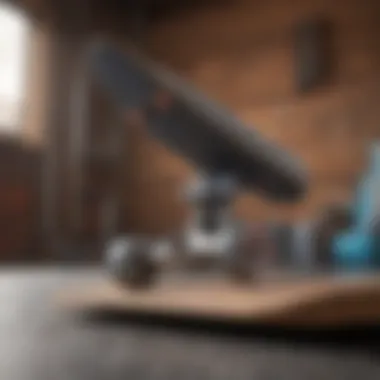

Maintaining Your Pre-Built Skateboard
Maintaining your pre-built skateboard is a fundamental aspect of skateboarding that is often overlooked. Skating involves various elements that can wear and tear considerably, and regular maintenance not only prolongs the lifespan of the board but can also enhance overall performance. A well-maintained skateboard can significantly improve ride quality, safety, and responsiveness. Neglecting maintenance, on the other hand, can lead to unexpected breakdowns, reduced performance, and potentially even injury. Therefore, recognizing the importance of ongoing care is vital for all skaters, regardless of skill level.
Routine Maintenance Practices
Routine maintenance should be seen as as important as the initial purchase of your skateboard. Here’s a closer look at the essential practices that can keep your board in prime condition:
- Regularly Check the Hardware: Make it a habit to inspect the screws, bolts, and other fasteners to prevent loosening over time. Using a skate tool can make this process seamless.
- Clean the Bearings: Bearings should be cleaned regularly to remove dirt and debris. A simple method involves removing the wheels, using some light oil or a cleaning solution to clear out any grime—just don’t soak them.
- Inspect and Replace Grip Tape: Over time, grip tape can lose its tackiness. If yours feels slippery, consider replacing it. New grip tape not only enhances control but also adds a fresh look.
- Keep the Wheels and Trucks Clean: Check for flat spots on the wheels and ensure the trucks are properly lubricated. You might need to tighten them occasionally too, especially if you are skating hard.
Here’s a checklist of routine practices you can follow:
- Inspect daily for any loose components.
- Clean the board after every few rides.
- Replace worn grip tape based on performance needs.
- Tighten the trucks if they feel loose.
"A little bit of care goes a long way in extending the life of your skateboard."
Troubleshooting Common Issues
Even the best boards are prone to issues from time to time. Recognizing the signs and knowing how to troubleshoot can save a lot of time and hassle:
- Wobbly Ride: If you notice your skateboard wobbling while riding, check the truck tightness. They may be too loose or misaligned, which could lead to instability.
- Slow Wheels: If your wheels don’t seem to be rolling as smoothly as they used to, it might be time to clean or replace the bearings. Dust and debris can severely impede movement.
- Board is Unresponsive: This could be a sign that your board is not adequately designed for your weight or terrain. Ensure you have chosen the right board type that complements your style of skating.
- Cracked Deck: A crack in the deck poses a serious safety risk. If detected, it’s best to replace the deck altogether rather than risking injury.
Addressing these common problems can be quite straightforward if you know what to look for. Here’s a quick troubleshooting guide:
- Check tightness of trucks and wheels.
- Clean or replace bearings as needed.
- Assess board type and dimensions.
- Inspect for cracks and consider replacing your deck.
By prioritizing regular maintenance and addressing any issues promptly, you can enjoy a smoother ride and greatly enhance your overall skateboarding experience.
The Role of Pre-Built Skateboards in Extreme Sports
Pre-built skateboards hold a significant place in the realm of extreme sports, serving not only as a functional tool for athletes but also as a representation of style, culture, and community. As extreme sports gain traction across various platforms, the demand for accessible, robust, and ready-to-ride options like pre-built skateboards continues to rise. These boards enable riders of all levels—whether novice or pro—to participate without the daunting task of assembling a custom setup from scratch.
One notable advantage of pre-built skateboards in extreme sports is their availability. Most shops offer a vast array of options that cater to diverse interests, be it downhill racing or street skating. This accessibility allows enthusiasts to quickly hit the ground running, fostering a sense of belonging in the larger skating community.
Integration into Various Extreme Sports Disciplines
Pre-built skateboards are versatile, finding their space in various extreme sports disciplines. Consider, for a moment, the evolution of skateboarding itself. From the corrosion of traditional street skating to the rise of park and vert skating, pre-built options have remarkably evolved in tandem.
Ultimately, these skateboards enhance rider performance in numerous categories:
- Street Skating: These boards are typically compact, designed for trick executions on urban landscapes.
- Park Riding: Equipped with a wider deck and resilient trucks, these boards dominate the ramps and bowls in skate parks.
- Longboarding: Emphasizing stability, pre-built longboards cater to cruising and carving down hills, adding an exciting element to the thrill of speed.
- Freestyle: Boards designed for flatground tricks offer unique dimensions, enabling riders to express creativity in their movements.
Regardless of discipline, skateboards designed for extreme sports facilitate skaters’ ability to perform tricks, navigate complex routes, and find their footing in competitive environments.
Cultural Impact on Skateboarding Communities
The cultural influence of pre-built skateboards extends beyond their utility. They are deeply intertwined with the communities around them, often serving as both a conversation starter and a status symbol. The skateboard itself can reflect personal style, beliefs, and aspirations. For some, it symbolizes a lifestyle, while for others, it acts as a passport to garner a sense of belonging within the skateboarding culture.
Social media has amplified this cultural aspect significantly. Platforms like Instagram and TikTok serve as showcases where skaters display their skills, share tricks, and even highlight various skateboard brands. The very design of a board can spark discussions about ethics in manufacturing and sustainability, creating opportunities for broader social dialogue within the community.
"A skateboard is more than wood and wheels; it’s a bridge to new friendships and cultural explorations."
In summary, pre-built skateboards play a significant role in diminishing barriers in extreme sports, promoting inclusiveness and fostering a thriving community. The integration across various disciplines not only enhances performance but also cements skateboarding's status as an essential mode of expression that continues to influence countless lives worldwide.
Ending
In wrapping up this exploration into pre-built skateboards, it becomes clear that the significance of making an informed decision in this realm cannot be overstated. Choices made early on can shape not just one’s riding experience, but also their engagement with the skateboarding culture at large. While pre-built skateboards offer an accessible entry point for newcomers, understanding what lies beneath the surface helps in selecting a board that not only meets certain standards but also resonates with personal riding style.
Reflecting on Pre-Built Skateboard Choices
When considering pre-built skateboards, various factors come into play. Each component – from the deck to the wheels – contributes to the overall riding experience. Potential riders should pause to reflect on their needs, preferences, and ambitions within the sport. For example, a skateboard suited to street tricks may differ vastly from one designed for cruising or downhill riding. The luxury of choice stands in stark contrast to custom builds, which require deeper knowledge but often do not guarantee better performance.
Key considerations might include:
- Skill Level: Beginners may prioritize stability and ease of control.
- Terrain: Urban environments vs. parks dictate distinct board designs.
- Brand Reputation: Some brands are renowned for quality, while others may cut corners.
By thoughtfully reflecting on these elements, riders can choose a pre-built skateboard that aligns well with their particular riding style, ensuring a more satisfying experience.
Future Trends in Skateboarding
Looking ahead, the landscape of skateboarding—especially when it comes to pre-built models—further diversifies. The increasing awareness of sustainability pushes brands to evaluate materials and manufacturing processes. Some manufacturers are beginning to explore eco-friendly materials that do not compromise performance. Keeping an eye on such shifts can make riders feel good about their choices, knowing they contribute to a healthier planet.
Moreover, technological advancements promise to enhance skateboard performance. Things like improved wheel designs and advanced composite materials are set to revolutionize conventional perspectives on skateboards. Mobility features, such as foldable designs or integrated tracking systems, may soon cater to those who use skateboards as a primary means of transport.
As skateboarding continues to evolve, the blend of technology and tradition offers new avenues for exploration, potentially reshaping not just how we ride but why we ride.


